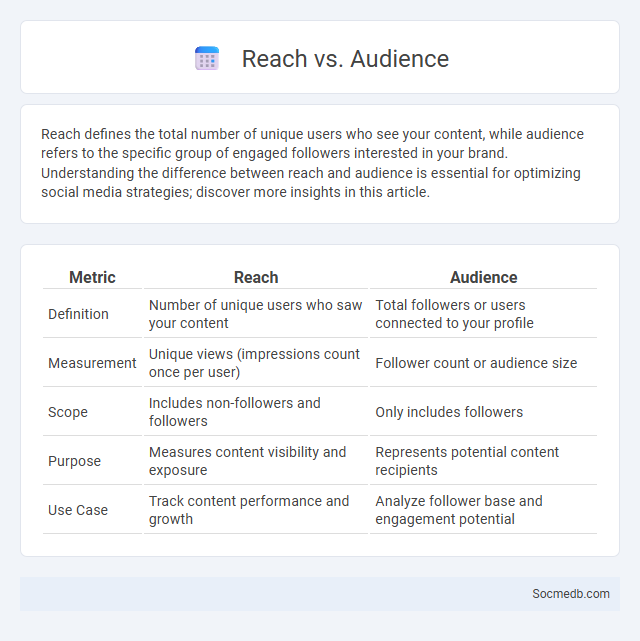
Photo illustration: Reach vs Audience
Reach defines the total number of unique users who see your content, while audience refers to the specific group of engaged followers interested in your brand. Understanding the difference between reach and audience is essential for optimizing social media strategies; discover more insights in this article.
Table of Comparison
| Metric | Reach | Audience |
|---|---|---|
| Definition | Number of unique users who saw your content | Total followers or users connected to your profile |
| Measurement | Unique views (impressions count once per user) | Follower count or audience size |
| Scope | Includes non-followers and followers | Only includes followers |
| Purpose | Measures content visibility and exposure | Represents potential content recipients |
| Use Case | Track content performance and growth | Analyze follower base and engagement potential |
Understanding Reach and Audience: Key Definitions
Reach defines the total number of unique users who see your social media content, providing a clear metric of audience size. Audience refers to the specific group of users targeted by content based on demographics, interests, and behaviors, crucial for tailored marketing strategies. Understanding reach and audience allows marketers to optimize content delivery, increase engagement, and measure campaign effectiveness effectively.
What is Reach in Digital Marketing?
Reach in digital marketing refers to the total number of unique users who see your content or advertisements on social media platforms. It measures the breadth of your campaign's audience exposure, helping you understand how many individuals your brand message has contacted. Maximizing your reach increases the potential for engagement and brand awareness among your target demographic.
Exploring Audience: Who Are You Targeting?
Understanding your target audience on social media involves analyzing demographics, interests, and online behaviors to tailor content effectively. Utilizing tools like Facebook Audience Insights and Google Analytics helps identify age groups, geographic locations, and engagement patterns that define your ideal followers. Creating detailed audience personas based on this data enhances message relevance, boosts engagement rates, and drives higher conversion.
Differences Between Reach and Audience
Reach on social media refers to the total number of unique users who have seen a specific piece of content, measuring the breadth of content exposure. Audience encompasses the group of users who regularly follow or engage with a brand's social media profiles, representing the core, consistent community. While reach indicates the potential spread and visibility of content, audience defines the loyal, repeat users contributing to long-term engagement and brand growth.
Measuring Reach: Tools and Metrics
Measuring reach on social media involves analyzing key metrics such as impressions, unique viewers, and engagement rates to understand how widely your content is distributed. Tools like Facebook Insights, Twitter Analytics, and Instagram Insights provide detailed data to track audience demographics and content performance. To optimize your social media strategy, you need to regularly assess reach metrics and adjust your posts to maximize visibility and impact.
Measuring Audience Size and Engagement
Measuring audience size on social media involves tracking metrics such as follower count, reach, and impressions to evaluate the potential visibility of content. Engagement rates are determined by analyzing likes, comments, shares, and click-through rates, reflecting how actively users interact with posts. Combining these data points helps brands optimize content strategies and improve targeting for higher conversion rates.
The Impact of Reach on Campaign Performance
Maximizing reach in social media campaigns directly boosts impressions and audience engagement, increasing the likelihood of message retention and brand awareness. Your campaign's performance metrics, such as click-through rates and conversions, improve as more users encounter your content across diverse platforms. Optimizing reach through targeted strategies ensures your content reaches the most relevant and receptive audience segments.
How Audience Insights Influence Strategy
Audience insights provide critical data on demographics, behaviors, and preferences, enabling you to tailor content that resonates deeply with your target market. Leveraging analytics tools helps identify peak engagement times and content types, optimizing your posting schedule and message relevance. Understanding these insights drives more effective campaigns, increased reach, and higher conversion rates in your social media strategy.
Combining Reach and Audience for Maximum ROI
Combining reach and audience targeting on social media maximizes ROI by delivering content to the right people at scale. Leveraging data analytics and advanced segmentation ensures campaigns engage high-intent users while expanding brand visibility across relevant demographics. Integrating these strategies optimizes ad spend efficiency and drives measurable conversions.
Reach vs Audience: Which Matters Most for Your Goals?
Reach measures the total number of unique users who see your social media content, while audience refers to the specific group of engaged followers interested in your brand. For maximizing impact, focusing on an engaged audience often drives higher conversion rates and brand loyalty. Understanding your goals helps determine whether expanding reach or nurturing a targeted audience best supports your marketing strategy.
 socmedb.com
socmedb.com